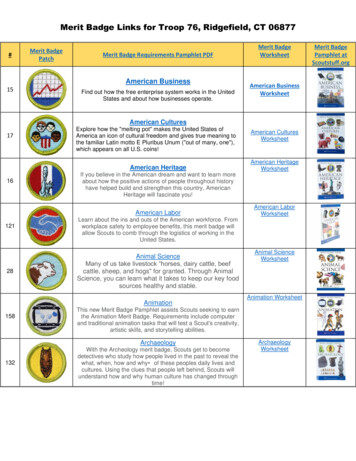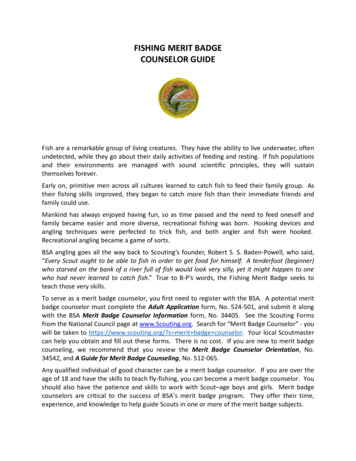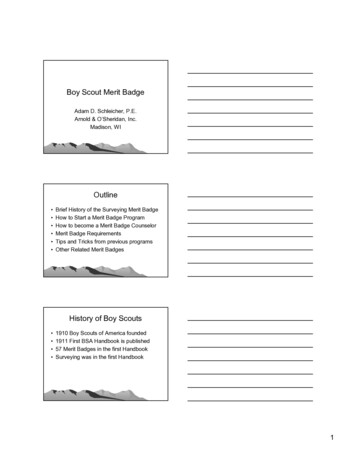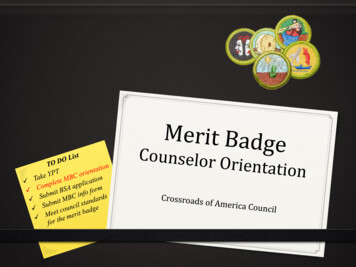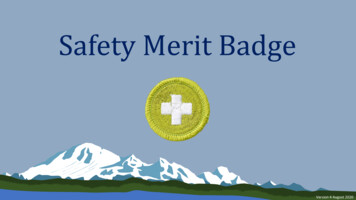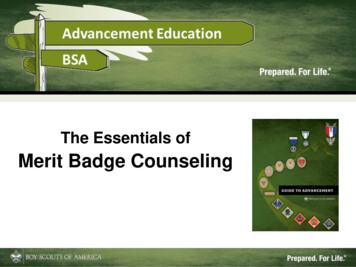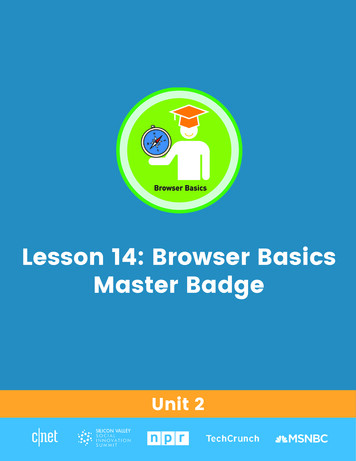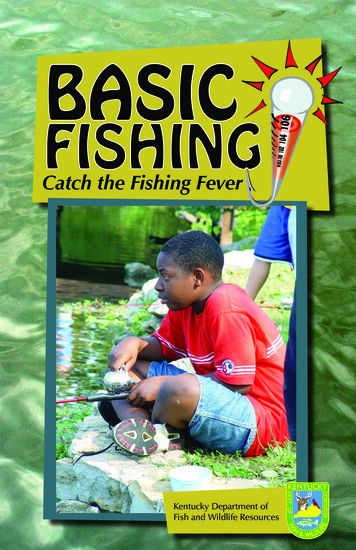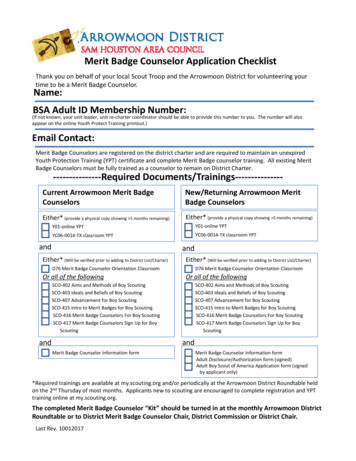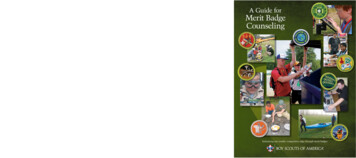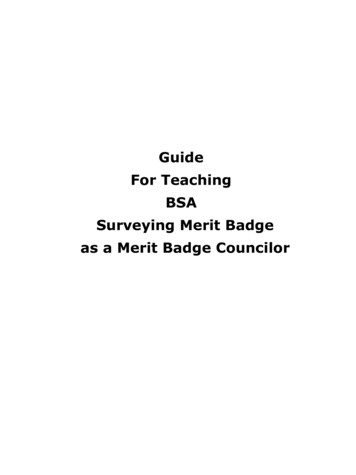
Transcription
1Fly FishingMerit BadgeSCOUTS BSA
2Requirement #1Health and Safety
Health & Safety Requirements3a. Explain to your counselor the most likely hazards you may encounterwhile participating in fly-fishing activities and what you should do toanticipate, help prevent, mitigate, and respond to these hazards.Name and explain five safety practices you should always follow whilefly-fishing.b. Discuss the prevention of and treatment for health concerns thatcould occur while fly-fishing, including cuts and scratches, puncturewounds, insect bites, hypothermia, dehydration, heat exhaustion,heatstroke, and sunburn.c. Explain how to remove a hook that has lodged in your arm.
1a/b – Hazards, Prevention &Treatment1.2.3.4.5.6.HazardsGetting hooked1.DehydrationSun issuesHeat issues2.Wild animal bitesInsect bites5.3.4.6.4Prevention or TreatmentWear eye protection and a brimmed hat;learn hook removal techniquesDrink plenty of waterWear SPF-rated clothing; use sunscreenWear light, breathable clothing; stay out ofdirect sun; drink plenty of waterAvoid wild animalsWear insect repellent
1a/b – Hazards, Prevention &TreatmentHazards5Prevention or Treatment7.Falls7.Use a hiking/wading staff8.Cuts8.Bring a First Aid kit9.Falling in;drowning9.Wear a PFD, especially in running water or ona boat10.Weather10.Check weather before you go; bring raingear11.Lightning/storms11.Seek shelter; keep your rod down low12.Getting lost12.Create a trip plan; leave it with an adult. Fishwith a buddy. Bring a compass & map.
61c - Removing an Embedded HookThe method you use depends on the hook type and how deep it went.IMPORTANT NOTES: If the hook is embedded in or near the eye or on the face or neck DONOT attempt to remove the hook! Cut the line and stabilize the hook if you can, then seek medicalattention immediately! All head injuries should be shown to a doctor. Keep your tetanusshots up-to-date.
71c - Removing an Embedded HookCut the line and (if possible) the lure off the hook. If the embedded hook is a treble hook, cut off all theuninvolved points. A wire cutter or Leatherman tool works great for this always have one with you when fishing. Wash your hands and clean the wound area before youbegin. Rinsing it with some antiseptic like Bactine is agood idea.
1c - Removing an Embedded HookThe Hard Way Push the hook the rest of the way out, untilthe barb is clear of the skin. Cut off the barb, and back it out the way itcame in. Yes, this is as much fun as it sounds. If the hook shank barbs are embedded, cut theeye off and pull it out by the barb.OUCH!8
1c - Removing an Embedded HookA (Super) Easy Way Always use barbless hooks or pinch down thebarb. If your hook is barbless, just back it out theway it came in.9
1c - Removing an Embedded Hook10The Best Way with Barbed Hook This is the best method to use if the hook is not barblessand the hook is not deeply embedded.Stabilize the hooked part on a flat surface. If the hook is inyour arm, place your arm on a rock or in your lap.Use a non-stretchy string or piece of heavy fishing lineand loop it twice around the hook.Press down on the eye so it’s flat against the skin.Yank the line sharply in the direction opposite the eye. Make sure you pull PARALLELto the skin. The hook should pop right out.Disinfect, add a little antibiotic ointment, slap on a Band-Aid and it’s all done. Keepfishing!
Health & Safety Game11 Youwill have 20 seconds to view each of the following slidesand write down the number of each health or safety itemthat you should bring on a fishing trip. Ifusing Zoom, we’ll run a poll after each slide to have youlock in your answers, then discuss everything after the 2nd set.
12Ready?You have 20 secondsto decide which health and safety items to bring
12345678910
14One More Ready?You have 20 secondsto decide which health and safety items to bring
11121314151617181920
16Requirement #2BalancedSystem
Balanced System Requirements17 Demonstratehow to match a fly rod, line and leader toachieve a balanced system. Discussseveral types of fly lines, and explain how and wheneach would be used. Reviewwith your counselor how to care for this equipment.
Balanced System When a rod, reel, fly line, leader, tippet and flyare correctly matched, the outfit is balanced. Rods are usually marked by line weight (5wt,7wt, etc.), length and number of pieces. Reels must be adequate to store backing, flyline, leader and tippet. The weight of the first 30 feet of fly linedetermines what rod it matches to yield abalanced system. Mark your line so you cantell what it is.18
19Fly Line “Size” vs. Weight vs. Fly SizeReading the chart - a 5wt example: Thefirst 30 feet of a 5wt lineweighs about 140 grains (9 gramsor 0.32 ounces) Unweightedflies from #22 to #12are most appropriate. Weightedflies from #24 to #16 aremost appropriate.
Common Fly Line Tapers20
Common Fly Line Types21
Types of Fly Rods22 Fixed Line (Tenkara, etc.) Modern Fiberglass, Graphite, Boron & “Blends” Traditional Bamboo Spey or Switch: Single-Handed vs. Two-HandedAge & Skill Level Appropriate
Fixed-Line Fly Tackle (Tenkara) Fixed-line fly-fishing is over1,800 years old! Easy to set up and cast. Excellent as entry-level fly rod. Can be very low-cost. Very compact and lightweight- great for backpacking!23
Fixed-Line Fly Tackle (Tenkara) No reel! The line is attached to a “Lillian”cord on the tip with simple, easy-to-tieand easy-to-remove knots. Most rods are long (11’ to 15’), include anumber of telescoping pieces, andcollapse into the short butt section. Lines can be as simple as a length offluorocarbon or nylon monofilament.Tapered, braided lines are also used. A thin monofilament tippet is attacheddirectly to the line with a tippet ring, lineline knot or loop-to-loop connection.rodsections24Lillianswivel(optional)
Standard Fly Tackle A complete outfit includes rod, reel, backing, line, leader andtippet. Rods are typically made of fiberglass, graphite, boron ortraditional bamboo. Graphite is the most popular. Outfits range from short, delicate rods for small mountain streamsto hefty “fighting” rods suitable for large saltwater fish weighinghundreds of pounds. A medium-action, 8½-foot, 5-wt outfit is a good all-purpose rod.Temple Fork Outfitters (TFO) makes a SCOUT rod just for Scoutsand Scouters.25
Some Fly Reels
Fly Rod, Reel & Line CareRule #1:1. Don’t put your reel in the dirt or sand!To clean the rod and reel:1. Gently rinse, sponge with warm, slightly soapywater, and then thoroughly rinse again.2. Wipe dry with a clean cloth and then air dry.3. When completely dry, loosen the reel drag andstore in a cool, dry place.To clean the fly line:1. Pull 40-60 feet of line from the reel.2. Wash in slightly soapy water, rinse and dry.3. Add line conditioner if desired.27
28Requirement #3Fly Fishing Knots
Tying it all Together29
Fly Fishing Knot Requirements30Demonstrate how to tie proper knots to prepare a fly rod for fishing:1.Tie backing to the arbor of a fly reel spool using an arbor knot.2.Tie backing to the fly line using a nail knot.3.Attach a leader to the fly line using a nail knot or a loop-to-loopconnection.4.Add a tippet to a leader using a surgeon's knot or a loop-to-loopconnection.5.Tie a fly onto the terminal end of the leader using an improvedclinch knot.
Getting Started with Knots 31When just starting out, begin with: Heavier fishing line or light cord Large hooks, or even a coat hanger bent like a hook. Get comfortable with each knot before trying to tie it withsmaller, more realistic materials. Practice, practice – before you get on the water
Rules for Strong Knots32 Knots must be neat! Make sure wraps are side-by-side and don’t overlap Lubricate knots before final tightening! Test your knots! It’s better for them to break in your hands than when a bigfish is on the -knotshttps://www.netknots.com/fishing knots
Arbor Knot33 The arbor knot is used to secure the fly linebacking to the fly reel arbor. It is good foranchoring the backing to the reel for bigfish that may take out more than just theleader and fly line. Note how the tag end of the line passesthrough the loop - important! After tying the stopper knot on the end ofthe tag end, trim the waste. Lubricate and then snug the knot down tothe arbor.
Nail Knot (Tube Knot)34 The primary use of the nail knot is to securethe backing to the back end of the fly line andto secure the leader to the front end of the flyline. It’s a bit tricky to tie, but you won’t have to doit very often. Make sure your wraps are even and neat.After snugging it up gently, lubricate itthoroughly before tightening. Trim excess line so the knot will flow smoothlythrough the rod guides.
35Surgeon’s KnotThe surgeon’s knot isused to connect twolines. Use it to build atapered leader or toconnect tippet to atapered leader. Make sure your knotis neat. Lubricatethoroughly beforetightening.
Surgeon’s Loop(for Loop-to-Loop Connection)36 The surgeon’s loop is tied thesame way as the surgeon’sknot, except a loop is formedas shown. Add a loop to the end of yourtapered leader and to yourtippet, then connect themwith a loop-to-loopconnection. Make sure your knot is neat.Lubricate thoroughly beforetightening.
Loop-to-Loop Connection37 The loop-to-loop connection isformed as shown. Each line has a loop, whichclasp together and look like asquare knot when done right. If done wrong, a girth hitch isformed, which is weaker than aproperly formed loop-to-loopconnection. This connection can be used toconnect a tapered leader to afly line or the leader to a tippet.
Improved Clinch Knot38 If you want to tie your fishing linesecurely to a hook, swivel or lure, theimproved clinch knot is a good choice. This widely-used fishing knot is moresecure than the regular clinch knotowing to an extra tuck under the finalturn, making it suitable for holding on tostrong fish. As usual, lubricate the knot beforetightening and cut the excess tag end.
39Requirement #4Flies
Fly Tying Requirements40 Explain how and when each of the following types offlies is used: dry flies, wet flies, nymphs, streamers,bass bugs, poppers, and saltwater flies. Tell what each one imitates. Tie at least two types of the flies mentioned in thisrequirement.
A Few Different Types of FliesDry FlyEmergerStreamerWet FlyNymphSaltwaterCritterCrayfishCheck out https://www.youtube.com/watch?v 95LsX9a8WQQ41Bass BugPopper
42Hook AnatomyHOOK LENGTHSHANKGAP (GAPE)Why are hook partsimportant to know? Fly parts areproportional tohook parts. Parts of the hookare used tomeasurematerials beforethey are tied on. Parts in red areused most often.EYE
43Some Hook Types
Basic Fly Tying Tool Kit44 Vise – to firmly hold the hook Thread bobbin with thread – for tyingmaterials on the hook Bobbin threader – to pull threadthrough the bobbin tube Bodkin – for picking out materials &applying head cement Hackle pliers – for wrapping hackle Scissors – for cutting materials & thread Half hitch tools – for applying halfhitches to secure the finished fly
Basic Fly Tying Skills Securing the thread (jam knot) Forming a thread base Using the hook to measure materials Tying on materials (critical pinch, thread torque) Wrapping materials (palmering, etc.) Cutting off excess materials Building a neat thread head Tying off and sealing the head45
Fly Tying Best Practices46 Know what you’re trying to simulate – size, shape, color, and especially behavior. Invest in quality tools. Be prepared: Select the right hook, thread and materials for your fly. Lay out only what you need. Keep tools and materials in order. Keep flies in proportion – use the hook to measure parts. NO SLACK!!! Maintain thread control at all times. Tie several of each fly – practice makes perfect! Keep natural materials in sealed containers – no bugs!
47Requirement #5Fly Casting
Fly Casting Requirements 48Demonstrate the ability to cast a fly 30 feetconsistently and accurately using both: Overhead casting techniques and Roll casting techniques
Principles of Fly Casting491.You must get the end of the fly line moving before you can make aback or forward cast.2.Once the line is moving, the only way to load the rod is to move thecasting hand at an ever-increasing speed and then bring it to a quickstop.3.The line will go in the direction the rod tip speeds up and stops - it goesin the direction that the rod straightens when the rod hand stops.4.The longer the distance the rod travels on the back and forwardcasting strokes, the less effort is required to make the cast.
Casting for Accuracy There are two imaginary lines between youand the target: The eye-to-target line. The hand-to-target line.Normally these are slightly apart: 50The distance from your hand to your eyes.Lining up the rod between your eyes cangive you greatly improved accuracy.Using two hands can help too – especially forbeginning casters.30 feet into a coffee cup?No Problem!
Casting for Distance51Keep your loops tight and line speed high. Keep the rod elevated at the back and forward stops for tight loops. Open your stance and move your body to lengthen the stroke. Learn how to double-haul to increase line speed. Keep your line path completely straight - 180ᵒ between back and forward casts. Aim above the target on the final forward stroke.
Roll Cast1. Lift the rod tip up slowly and gently stop when the rod tip isslightly behind you (about 1 o’clock). Wait a moment to letthe line settle to form a D-shaped loop behind you and an“anchor” on the water’s surface in front of you.2. Accelerate straight forward, then speed up and quicklystop the rod tip.3. Aim the cast above the target so the line unrolls before you.Let the rod drift down as the line settles to the water.52
Overhead Cast 1/21. Lower the rod, point it at the target, and take anyslack out of the line.2. Lift the rod tip, slowly at first, then smoothlyaccelerate the backstroke to get the line off thewater.3. Quickly speed up the backstroke to load the rodand propel the line into a high back cast.53
Overhead Cast 2/24. Stop the rod quickly at about the 1 o’clock positionto form a tight loop as the line passes overhead.5. Pause for a moment as the back cast unrolls behindyou.6. Accelerate smoothly forward, slowly at first, thenspeed up to load the rod and propel the line forward.Aiming the cast above the target, stop quickly atabout the 10 o’clock position. Let the rod drift downas the line settles to the water.54
Tenkara Fly CastingFrom the 10 o’clock fishing position (A), raisethe rod to 12 o’clock (B) and stop for a briefmoment to let the line unroll behind you.55From 12 o’clock (B), stroke the rod to the 10o’clock position (C) and stop to let the lineunroll in front of you. Do NOT lower the rod.
56Requirement #6What Fish Eat
What Fish Eat Requirements57 Go to a suitable fishing location and observe whatfish may be eating both above and beneath thewater's surface. Explain the importance of matching the hatch.
58What Fish Eat The “Food Web” iscomplex.Water quality andwatershed featuresdetermine what can thrivethere.All critters need to eatwithout being eaten.Everything has unique waysof doing that (camouflage,numbers, speed, agility,size, etc.).Its good to be at the top ofthe food chain
What are the Fish Eating Here?Where should you look? Terrestrials and adult aquatic insects hide inshoreline grass, bushes and trees. Shakethem to see what falls or flies out. Aquatic insect nymphs hide under rocks,logs and water weeds. Lift some rocks orhold an aquarium net below some gravel.Stir it up to see what comes out. Crayfish, sculpin minnows and other crittershide in the same places. You may seesome when you lift a rock or stir the gravel. Look carefully in the shallows for minnows.Larger fish would certainly like to snack onthem.59
Mayfly Lifecycle60
Match the Hatch(Blue Ridge Mountains Hatch Chart)Reading the chart - May example: Flies to use include Blue WingedOlive, Adams, Elk Hair Caddis,Hendrickson, Light Cahill, Sulphur,and Eastern Green Drake. Hook sizes are given for eachmonth. Fly size is based on hooksize. Note how small they are! Hatches depend on weather andwater conditions - always checkbefore you go! Why is all this good to know?61
Fish Lifecycle62 As fish become larger, theydepend on larger food sourceslike baitfish. Baitfish are simulated bystreamers, which can be tied to“match the hatch” or serve as anattractor.
63Requirement #7Leave No Trace &Catch and Release
LNT & C&R Requirements64Do the following:a. Explain the importance of practicing Leave No Tracetechniques. Discuss the positive effects of Leave NoTrace on fly-fishing resources.b. Discuss the meaning and importance of Catch andRelease. Describe how to properly release a fish safelyto the water.
Leave No Trace Core Principles651.Plan ahead and prepare5.Minimize campfire impacts2.Travel and Camp on DurableSurfaces6.Respect wildlife7.Be considerate of other visitors3.Dispose of waste properly4.Leave what you findHow do these core principles apply to fly-fishing?Check out https://lnt.org/leave-no-trace-fishing/.
Releasing Your Fish Handling the fish with wet hands, remove thehook and then cradle the fish in the wateruntil it recovers and swims off strongly on itsown. Facing up-current in moving water. Facing toward deeper water or shelter instill water. Do NOT move the fish forwardand backward to flow water through thegills. This can collapse the gills whenyou move the fish backward. Let itbreathe naturally.Take the time to make sure the fish is readyto go - usually a minute or less.
Kansas67Fishing Regulations SummaryRequirement #8Regulations
68Regulations Requirements Obtainand review the regulations affecting gamefishing where you live or where you plan to fish. Explainwhy they were adopted and what isaccomplished by following them.
69Regulations Each State has its own rules & regulations. See the Take Me Fishing website for links to each State’s regulations andto get a license. Go to https://www.takemefishing.org.License Information: Most states will send a downloadable PDF, whichyou can print and sign. You can also have the State send your licensein the mail.Take time to review your State’s fishing regulations. Be aware thatthey vary from State to State and from one watershed to another.
70Requirement #8Good OutdoorSportsmanlikeBehavior
Good Sportsmanlike BehaviorRequirements71 Discuss what good sportsmanlike behavior is and howit relates to anglers. Tell how the Outdoor Code of the Boy Scouts ofAmerica relates to a fishing enthusiast, including theaspects of littering, trespassing, courteous behavior,“catch and release”, and obeying fishing regulations.
Good Sportsmanlike Behavior72What does this mean? Leave No Trace. Follow the Outdoor Code. Release unwanted fish carefully andunharmed. Never litter or pollute the waters.Respect the rights of fishermen andothers who use the resource. Know and follow angling andboating regulations.Keep only the fish you want to eat. Share your knowledge with others.For more details go to e-rules-need-know/.
The Outdoor Code 1/2As an American, I will do my best to: Be clean in my outdoor mannersI will keep my trash and garbage out of lakes, streams, fields,woods, and roadways.I will treat the outdoors as a heritage.I will take care of it for myself and others. Be careful with fireI will prevent wildfire.I will build my fires only where they are appropriate.When I have finished using a fire, I will make sure it is cold out.I will leave a clean fire ring, or remove all evidence of my fire.
The Outdoor Code 2/2As an American, I will do my best to: Be considerate in the outdoorsI will treat public and private property with respect.I will use low-impact methods of hiking and campingI will LEAVE NO TRACE. Be conservation-mindedI will learn how to practice good conservation of soil,waters, forests, minerals, grasslands, wildlife, and energy.I will urge others to do the same
What Does the Outdoor CodeMean to a Fisherman?What about: LitteringTrespassingCourteous behaviorObeying fishing regulations75
Requirement #10Catch andIdentify a Fish
Fishing Requirements Catchat least one fishusing a fly rod and fly. Identifyit and quicklyrelease it live back intothe water. Discussthis experiencewith your counselor.77
What do you Need to Know toCatch and Identify a Fish? 78Catching Fish What do fish need to thrive? What are some of the best practices for fishing? Where can you find fish? What is the nature of fish?Identifying Fish See your state fishing website for fish identification information. Go to https://www.takemefishing.org/fish-species/ to identify both freshwater and saltwaterfish. For additional freshwater fish information go to a.html.
WHAT FISH NEED TO THRIVE Clean,79oxygenated water at the right temperature Aplace to safely feed* Aplace to safely rest* Aplace to hide from predators* Aplace to reproduce“Prime Lie”
BEST PRACTICES for FISHING80 Use barbless hooks or crush the barbs on your hooks. Practice STEALTH. Approach from behind (usually from downstream) tosneak up on fish. Act non-threatening - move slowly and keep yourarms and rod down. Dress in subdued colors to match the background- woods, rocks, sky, etc. Use fine line to avoid spooking fish. Position yourself and your line toavoid cross currents. Loud noises can scare fish, especially sloshing water. Wade gently. Usea rubber-tipped wading staff for stability.
The Importance of STEALTH Fish can be very skittish and spooky, especially if they’ve beendisturbed. They quickly react to predators (like you) and competitors(other fish). Only the quick and cautious survive to maturity and spawn. Water and other conditions can make your approach difficult: lack ofcover, clear water, still water, bright sky, etc. Wind and current can be your friends when they ripple the water anddistort the fish’s view. Wear unobtrusive clothing and use gear that blends with thebackground. No red shirts! No white hats! No shiny watches! No pinkrods!
Getting into Position Plan your attack. Study potential paths. What’s the best approach? Stay out of sight! Use cover – trees, bushes, rocks, tall grass, roughwater, etc. – to mask your approach and casting position. Fish from the bank if possible. If you enter their domain, the fish willknow. If you must wade, move slowly (2 steps per minute or less). Keep a lowprofile. Become the Heron After you are in position, rest the water to allow fish to resume activefeeding – take the time to observe what they’re eating, above orbelow the surface. Think about your cast and where the fly must go.
FINDING STREAM FISHNEAR SEAMS83
FINDING STREAM FISHNEAR OBSTRUCTIONS84
FINDING STREAM FISHBELOW LEDGES85
FINDING STREAM FISHIN WEEDS86
FINDING FISH IN PONDS & LAKESIN THE SPRINGFrom Lake Fly-Fishing Manifesto by Mike Croft87
FINDING FISH IN PONDS & LAKESIN THE SUMMERFrom Lake Fly-Fishing Manifesto by Mike Croft88
FINDING FISH IN PONDS & LAKESIN THE FALLFrom Lake Fly-Fishing Manifesto by Mike Croft89
FINDING FISH IN PONDS & LAKESIN THE WINTERFrom Lake Fly-Fishing Manifesto by Mike Croft90
FISH CAN SEE YOU !91Fish Cone of Vision (Rule of 6)– Example: a fish in 2 feet of water. How far awaydoes a 6 ft tall angler need to be?– Answer: 6 X height above water 36 feet (unless the 6 ft angler is wading, kneeling,sitting, crawling or lying on his stomach). To get closer, get on your hands and kneesand cast sidearm or hide behind a rock, bush, tree, etc. Wear drab clothing. Moveslowly. Don‘t cast a shadow on the water. STEALTH!
FISH CAN HEAR & FEEL YOU ! Withtheir Lateral Line Walk the banks softly (and out of sight!) Watch your ripples when wading –slooow movementsLateral Line92
FISH TEMPERATURE PREFERENCES93
USGS RIVER TEMPERATURE vs. TIME(Rappahannock River, Fredericksburg VA) Use USGS water data to help you plan! See https://waterdata.usgs.gov/nwis/rt forwater data for the country. Select Data Category and GeographicArea to narrow your search. From the many sites shown, select thewater body you want. You can then select how data isdisplayed and the time period.This sample chart shows idealtemperature ranges for Smallmouth Bass. Pick a time of year when the fish arehappy and hungry!94
Fish Identification:Can you Identify These Fish?95
96Requirement #10Cleaning andCooking Fish
Cleaning & Cooking Requirements97 Ifregulations and health concerns permit, clean and cook afish you have caught. Ifyou are unable to catch a fish for eating, acquire a fish,clean the fish you acquired, and cook the fish you acquired. (It is not required that you eat the fish.)
BEST PRACTICES for CLEANING FISH Cleanyour fish as soon as possible, whileit’s fresh. You Keep Afish on ice or refrigerated untilthey’re cleaned. Makesure everything is clean and readybefore starting. Youcan use any sharp knife to clean afish, but a thin, flexible filet knife is best. Knivesshould be very sharp and fish canbe slippery – be careful!98can wear plastic or rubber gloves tokeep your hands clean while you work.Kevlar or metal mesh cleaning glove ishighly recommended. Seehttps://www.amazon.com/s?k fish cleaning glove. Keeprinsing the fish in cool water as youclean it and give it a final rinse whenyou’re done. Discardthe carcass and guts, and cleanup when you’re done.
CLEANING – STEP 19999
CLEANING – STEP 2100
CLEANING – STEP 3101
CLEANING – STEP 4102
CLEANING – STEP 5103
FILLETING – STEP 1104
FILLETING – STEP 2105
FILLETING – STEP 3106
MAKING STEAKS107
BEST PRACTICES for COOKING FISH There are many delicious ways to cookfish, including:Grilling Poaching Steaming Broiling Baking FryingWhen cooking with Scouts, give themchoices of spices, sauces, condiments, etc. Let them do as much as possible. Foil dinners are great for this.Make sure fish are well cooked, but notoverdone.This is a delicate balance, especially with“dry” cooking methods like grilling, broilingand baking, and with delicate fish like trout. Most fish cook quickly. Test frequently for doneness by slicing to seethe inside or pushing with a fork to test forfirmness. Remember KISMIF – Keep It Simple,Make It Fun 108 Recipes are available:Online Recipe books Mom, Grandma or a neighbor – ask! For some great advice on how to cook with youth, the-classroom-best-practices-guide.pdf/
GRILLING When you're grilling fish, keep a close watch. Fish onlytakes a few minutes per side to cook. Brush the fish lightly with oil or spray with nonstickcooking spray. Place fish near the edge of the grill, away from thehottest part of the fire. Don't try to lift up the fish right away; it will be stuck tothe grill. Start checking for color and doneness after a fewminutes, once the fish starts to release some of its juices. Flip the fish over when you see light grill marks forming.109
POACHING To poach fish, use vegetable or chicken stock, ormake a court-bouillon, a homemade broth ofaromatic herbs and spices. Use a pan big enough to lay each piece of fish downflat. Pour in enough liquid to just barely cover thefish. Bring the liquid to a simmer, and keep it there. If you see bubbles coming up from the bottom of thepan, it's too hot - the liquid should "shimmer" ratherthan bubble. The ideal temperature is between 165and 180 degrees F. Gently simmer until the fishflakes easily.110
STEAMING Steaming produces a mild-tasting fish that is oftenpaired with a flavorful sauce. Rub the fish with spices, chopped herbs, ginger,garlic, and chile peppers to infuse flavor while itcooks. Use a bamboo steamer or a folding steamer basketwith enough room for each piece of fish to lie flat. Pour about 1½ inches of water into the pan, placethe steamer over the water, cover the pot, and bringthe water to a boil. Begin checking the fish for doneness after 10minutes.111
Cut the line and (if possible) the lure off the hook. If the embedded hook is a treble hook, cut off all the uninvolved points. A wire cutter or Leatherman tool works great for this - always have one with you when fishing. Wash your hands and clean the wound area before you begin. Rinsing it with some antiseptic like Bactine is a
